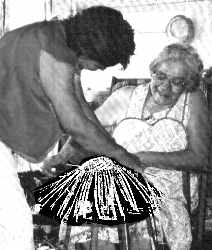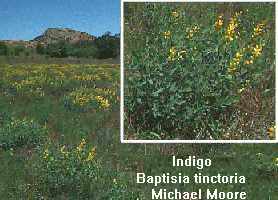 |
Indigo plants grow wild over much of the U.S. including the 6 Nations areas in the northeast. In addition to making a deep blue dye from its roots, an infusion as a skin wash was used to treat sores and skin ulcers. |
|---|---|
| Two generations of Ganienkahake (Mohawk) women from Akwasasne Reservation that spans th U.S. - Canada border, work on the lid for the big splint hamper in Gertrude Gray's kitchen. Mary imbricated the twill-weave. which means working over and under a second splint (indigo-dyed deep blue), on top of the one initially woven in place. Gertrude uses a large kitchen bowl as a mold for the lid. Mother and daughter worked about 30 hours to complete the hamper and lid, and about 15 hours the previous year to prepare, natural-dye, and cure the splints. Brown ash, "the basket trees" are dying from Maine to Canada, due to industrial pollution caused by developments since opening the St. Lawrence Seaway in the early 1950's. Most black ash died years ago. | |
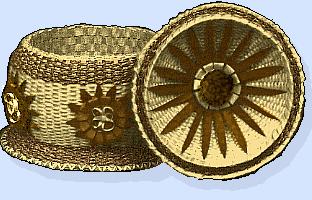 Charlotte Delormier, Cornwall Island, St. Regis Reserve, Mohawk, made this nifty sewing basket, in 1981. 9 x 10", brown ash splints and sweetgrass. The inside of the lid that we're looking at has a pincushion forming the center of a splint flower. The wide trim at top and bottom is braided dyed sweetgrass -- each weaver is a braid. The basket is double-woven from the bottom, checkerboard inside, a wicker-like long stitch outside. Looped splints form a decoration of ribbon flowers, repeated on the outside of the lid. Charlotte Delormier, Cornwall Island, St. Regis Reserve, Mohawk, made this nifty sewing basket, in 1981. 9 x 10", brown ash splints and sweetgrass. The inside of the lid that we're looking at has a pincushion forming the center of a splint flower. The wide trim at top and bottom is braided dyed sweetgrass -- each weaver is a braid. The basket is double-woven from the bottom, checkerboard inside, a wicker-like long stitch outside. Looped splints form a decoration of ribbon flowers, repeated on the outside of the lid. | |
 |
Clara Keezer, Passamaquoddy elder from Pleasant Point, Maine reservation, made this 7" high by 10" diameter basket in 1982. Commercial red dye marks the spiral, but the sweetgrass (hierochloe odorata) -- which is woven in the pattern of top spiral and bundled for the lid's rim -- is the natural green of the stems. |
| Clara Keezer wove this 7" strawberry- shaped curlicue basket in 1980 on a very old wooden mold, provided by traditional Passamaquoddy elder William Atwater, who used to weave heavy-duty potato baskets, and operate a basket sale shop at Pleasant Point. Commercial red and green dyes are used for the splints, but the bundled sweetgrass rims are natural-color. The light ivory splints are split from the outer 5 rings of a fresh log -- sapwood. Cured, they remain light, and also can be dyed. Heartwood is also "busted" for splints, but will be a light mahogany natural color (like the hamper and sewing basket) when cured. | 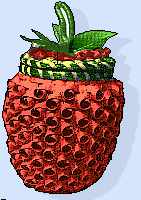 |
 |
Mik'maq Annie Paul (Shubencadie reserve, Nova Scotia) made the poplar splint flowers. Margaret Johnson (Escasoni reserve, Cape Breton Island, Nova Scotia) made the 14 x 14 x 15" poplar splint basket to hold them. Both made in 1981. |
| Poplar splint flowers -- elaborate roses -- were invented by Shubencadie Mik'maq Madeline Knockwood in 1937. The splint flowers are found in many Maritime Provinces Indian homes as symbols of Indianness. Displays of them are often given to churches for special offerings to the Virgin. Mrs. Knockwood died in 1945, but her invention is carried on by others at Shubencadie -- the reserve from which AIM martyr Anna Mae Pictou Aquash came from -- notably Annie Paul. The flowers and leaves are dyed with commercial dyes, but subtle shadings, stripes or flecks and leaf veins are possible by scoring the splintwood in the true artcraft flowers. | |
| Maine Aroostock Band Micmaq, whose reservation is at Presque-Isle, operate a tribally-owned craft shop, Micmac Images, (207/764-4001) selling useful ash splint baskets -- ranging in size from the huge laundry basket near the store window to tiny souvenir fancies, as well as ribbon shirts. Baskets are also a popular mail-order sales item. | 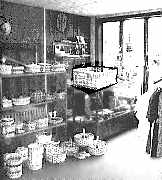 |
U.S. Micmacs are recovering from particularly devastating betrayals. In 1776 at the start of the U.S. revolution against England,, they were the first tribe to sign a specific treaty with the Commonwealth of Massachusetts on on behalf of the United Colonies of America, wherein Micmac and Maliseet tribes agreed to support the rvolutionaries against the British. Th rsult was all their land was taken and they recivd no governmental recognition as a tribe. In 1970, they gaind stat recognition as a tribe. But due to inadequate financial resourcs to document thir history and detrmine actual membership, they were excluded from th 1980 federal and state settlement of the Maine Indian land claims, so they gained federal recognition as a tribe, but not the significant financial and land benefits the Passamaquoddy and Penobscot tribes achieved. Throughout the 20th century, Maine Micmac have supported themselves by seasonal day labor in logging, river-driving, blueberry-raking, and potato-picking, often crossing to Canada to seek employment. Sale of splint basketry -- at first to surrounding farmers, later to tourists and collectors -- has always been a significant part of self-support. Maine basketmakers are worried, now, because of the die-off of the ash trees, caused by industrial pollution around the St. Lawrence Seaway. Some Tribal Info Sites
| |
